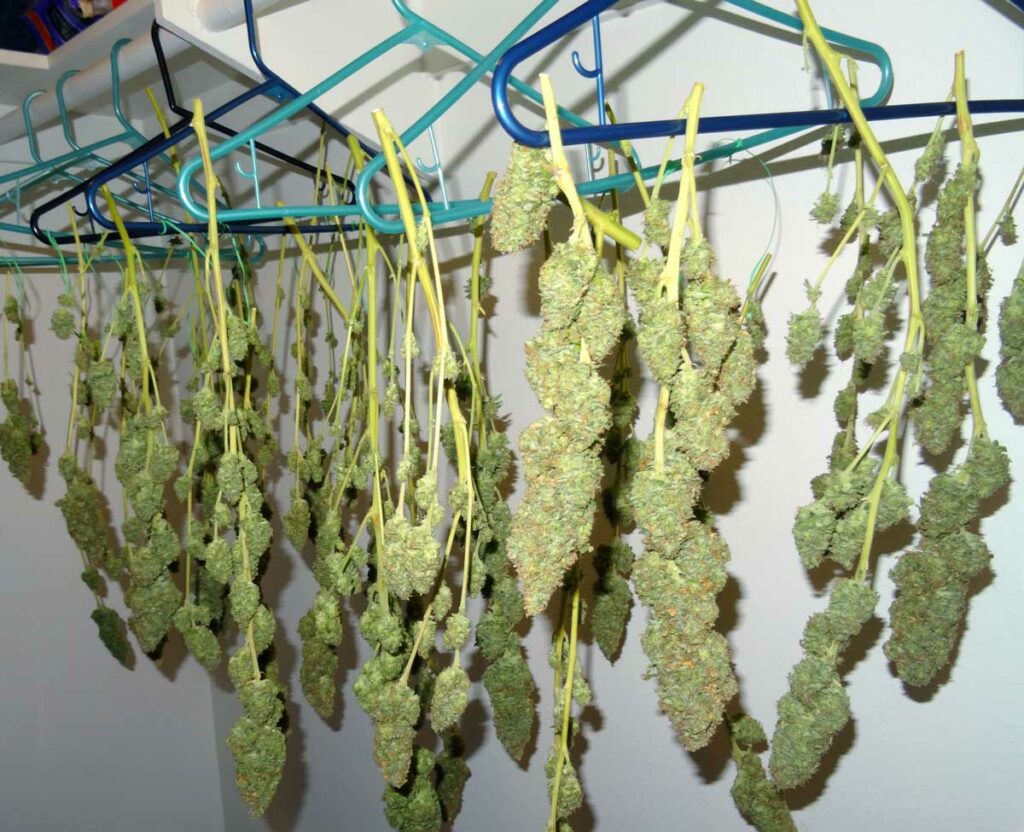


Once you decide to harvest your cannabis plant, there are several important steps before you can enjoy your buds. These processes include drying and trimming. Drying removes excess water molecules, making the buds easier to burn, while trimming involves cutting the sugar leaves close to the buds. Cannabis plants have two types of leaves: fan leaves, the large leaves growing from the stem, and sugar leaves, which grow close to the buds and contain trichomes. Both types of leaves are useful; fan leaves can be smoked or used to make teas, while sugar leaves are ideal for creating cannabis extracts or butter.
Before you cut your plant, first remove all the fan leaves.
After removing all the fan leaves, the question arises of how to cut the plant. Cannabis has many branches, and its buds grow at the ends. The best way to cut your plant is to cut it from the main stem close to the ground and then hang it upside down. This way, gravity helps the excess water in the plant flow to the buds, which helps degrade excess nutrients and sugars in the buds. Always cut the stems and avoid cutting through the buds, or you will lose part of your harvest.
If your plant is too large and space is limited, it is advisable to cut the branches individually or in pairs and also hang them upside down.

Alternatively, you can use specialized cannabis dryers, also known as flat drying. In this method, you place the buds on different drying layers. Drying cannabis is a crucial step, and it is important to follow certain rules to ensure the time and effort invested in growing your plant are not wasted. During the drying phase, the moisture content is reduced from 80 % to 25-30 %, depending on drying criteria.

First, avoid exposing your cannabis drying room to light. Light is known to break down THC, causing your buds to lose potency when dried in the light. So it’s best to keep the lights off and also make sure no sunlight comes through the windows.
The next important factor is humidity. High humidity can encourage the growth of mold or fungus, which could ruin your buds. Therefore, you should aim to dry your cannabis in an environment with 45% to 60% relative humidity. This process can take between 5 and 10 days, depending on the amount harvested. While higher humidity levels can produce tastier and more potent buds, they also increase the risk of mold and fungus.
Next, ensure proper ventilation. Sufficient air circulation allows fresh air to constantly reach your plants. However, if you use a fan for ventilation, avoid pointing it directly at your drying flowers. This could cause the aromatic compounds in your flowers to evaporate faster, resulting in a loss of flavor and aroma.
Temperature also plays an important role. 20 °C is considered ideal. This allows the buds to dry quickly enough to prevent mold and slowly enough to prevent cannabinoids and terpenes from evaporating. Some growers keep the temperature at 20 °C for the first few days and then lower it to 18 °C towards the end of the drying phase to slow down the moisture reduction.
You need to make a decision about this before harvesting. There are pros and cons to both methods, and neither is inherently better than the other as long as you adhere to the requirements of the drying process.
Wet trimming means trimming the plant right after harvest while it still contains a lot of moisture. Removing the sugar leaves while the plant is still wet allows it to dry faster. One downside of wet trimming is that cutting the sugar leaves can become a very tedious task. The trichomes and chlorophyll make the scissor blades very sticky, slowing down the process.
Dry trimming, on the other hand, involves hanging the plant without removing the sugar leaves and trimming them after drying. This method is less sticky and faster than wet trimming. However, the cons include a delay in the drying process due to the higher moisture levels retained by the sugar leaves, which also take up more space and increase the risk of mold. Some cannabis enthusiasts also claim that some trichomes are lost during dry trimming. Although still sticky, dry trimming is generally easier to perform than wet trimming.


This grower has opted for trimming after drying. The sugar leaves are still on the flowers during the drying phase and are then removed from the dried buds (dry trimming).
This grower has opted to remove the sugar leaves before drying (wet trimming):
Finishing the drying process: You’ll know your buds are ready when the stems crack easily when bent. They should make a dry cracking sound. If the buds are dried for 5-10 days at the appropriate temperature and humidity, some moisture (25-30%) should still be present in the buds. This slows down degradation processes. At this point, they are ready for the next step: curing.

Use the FYTA Beam as your personal plant assistant – for large buds that exceed all expectations!
